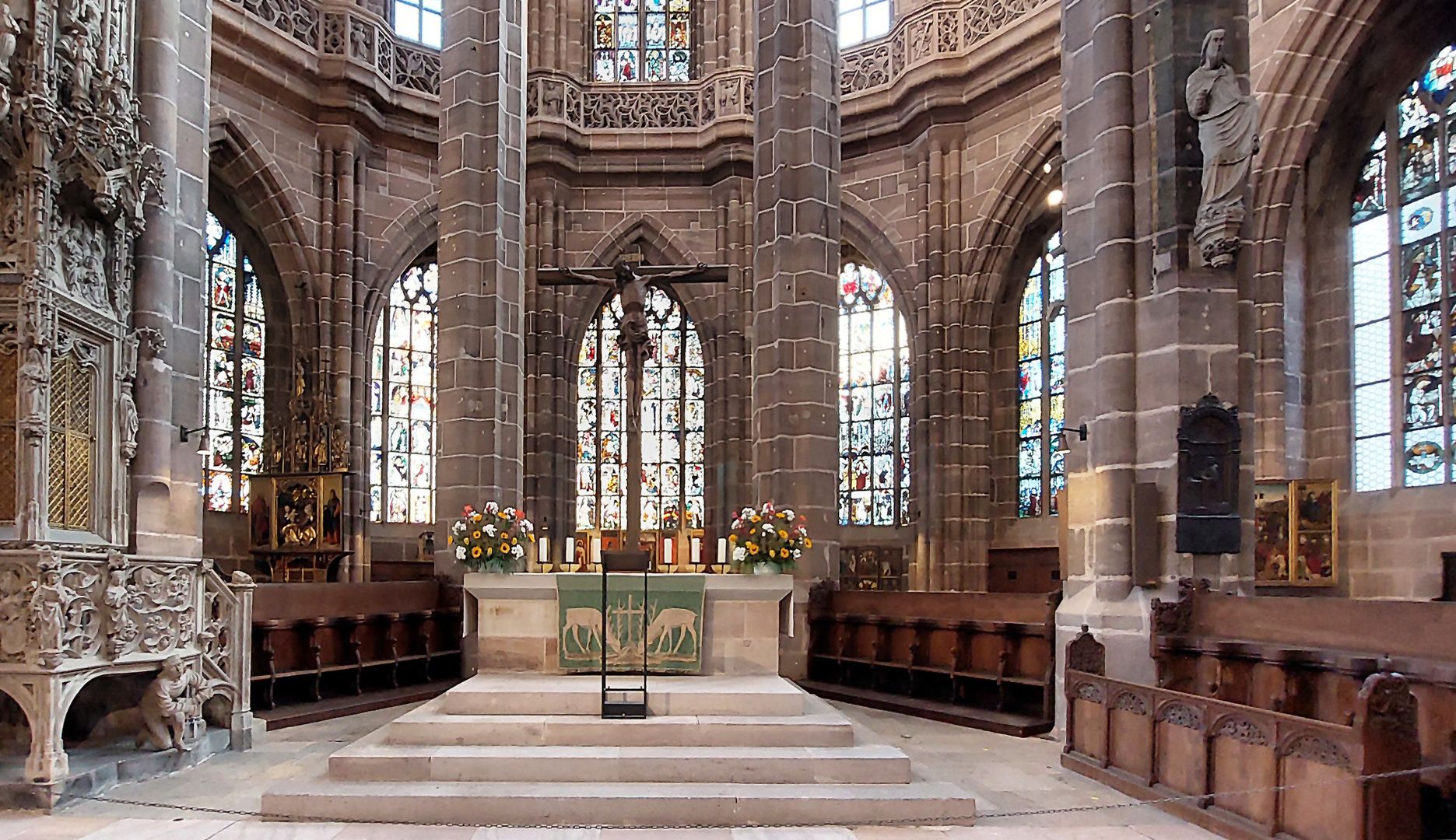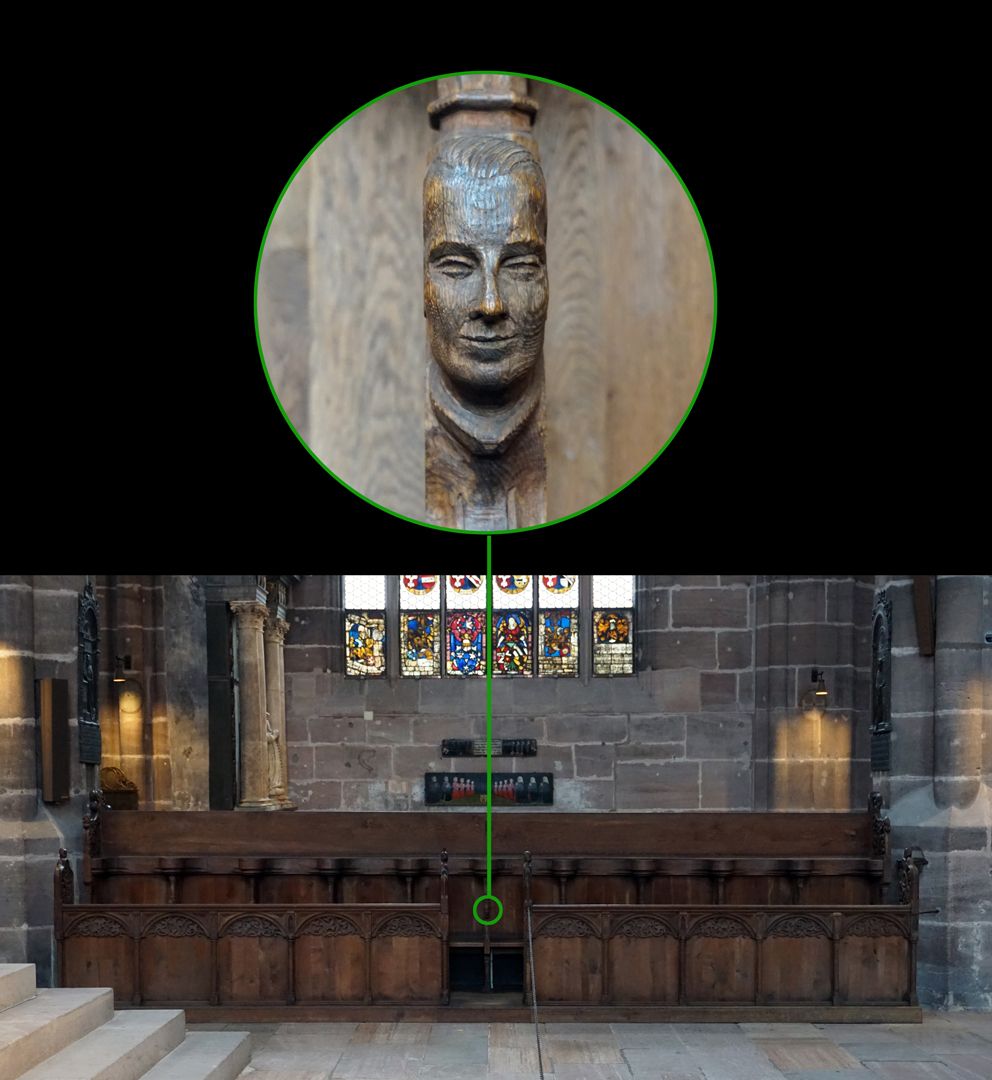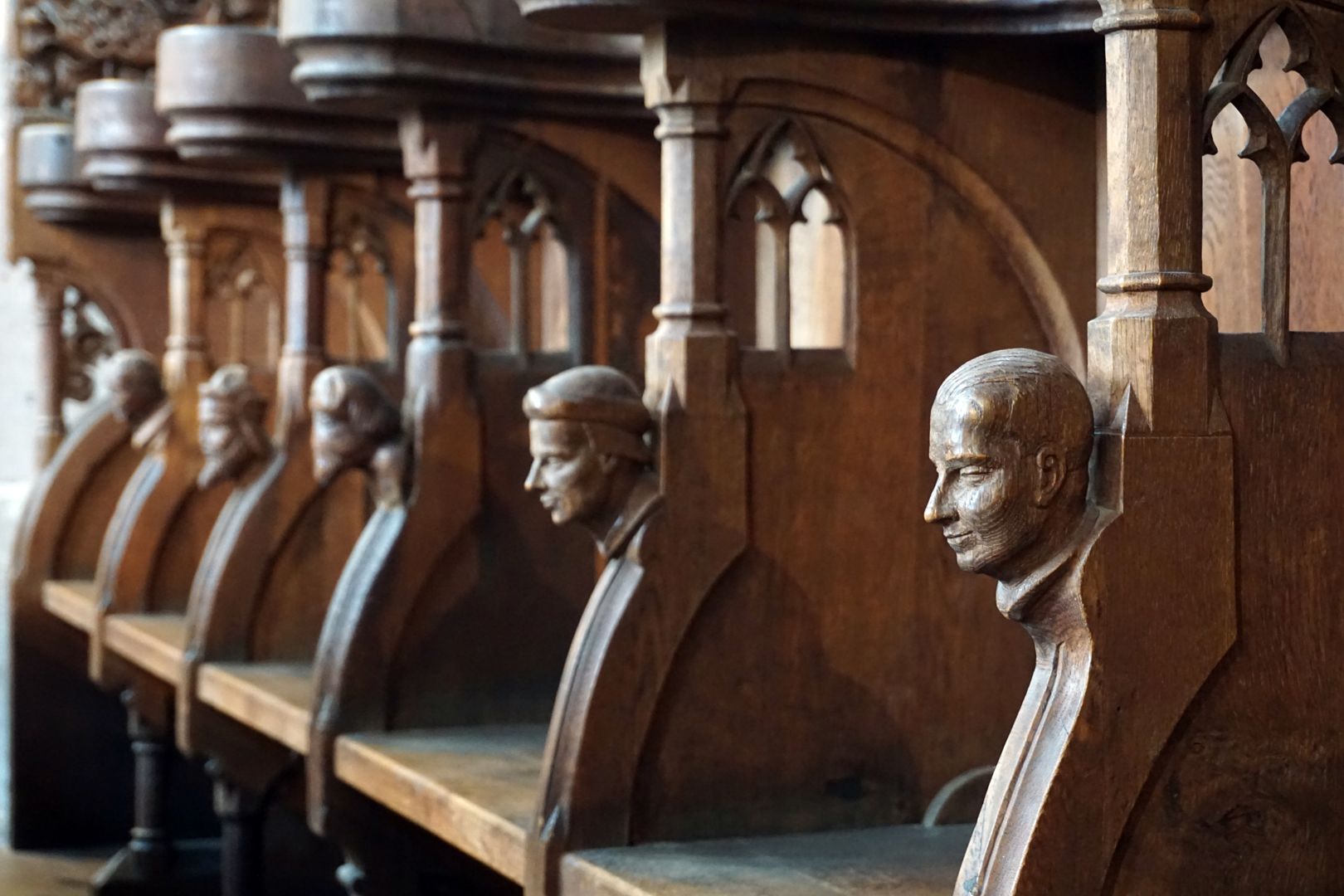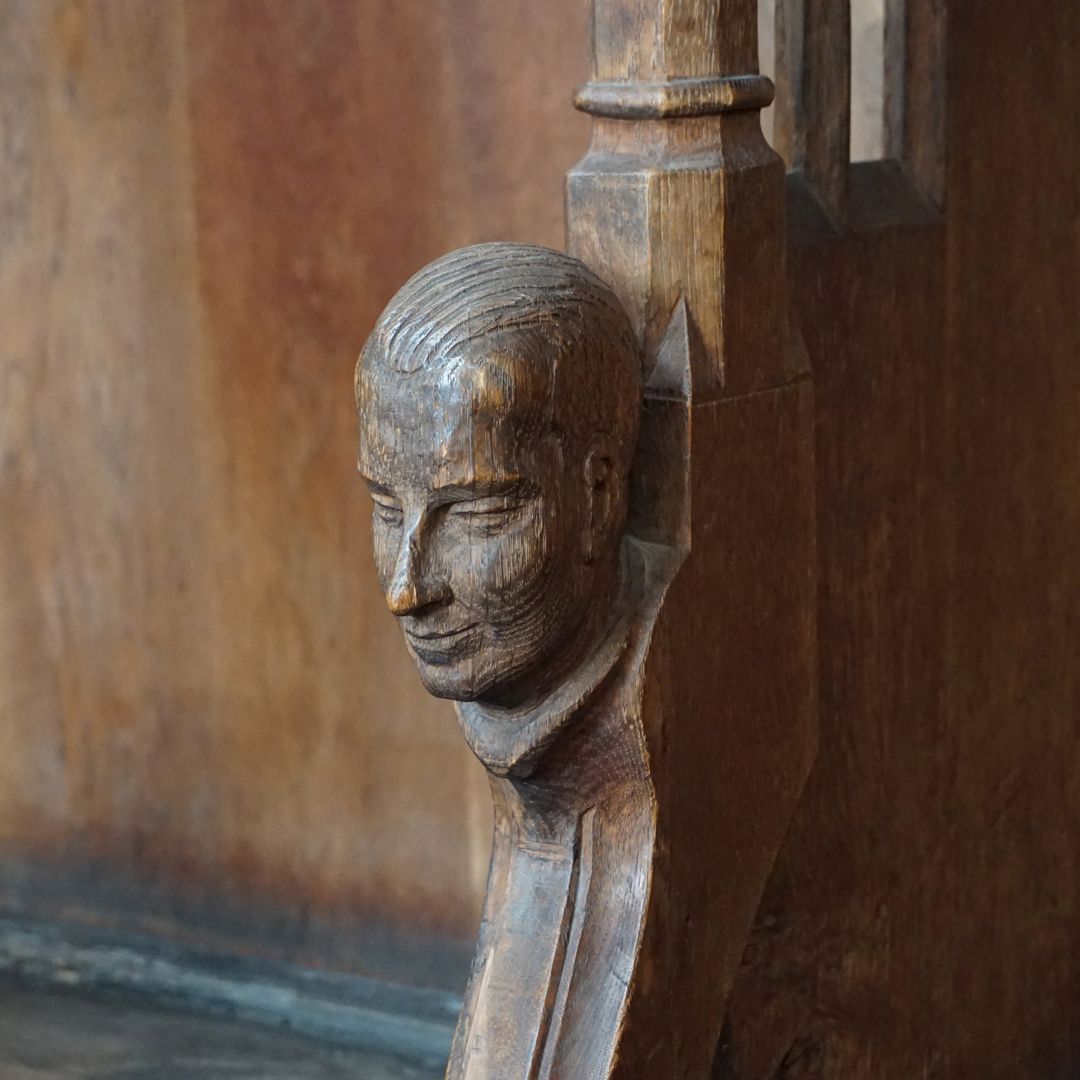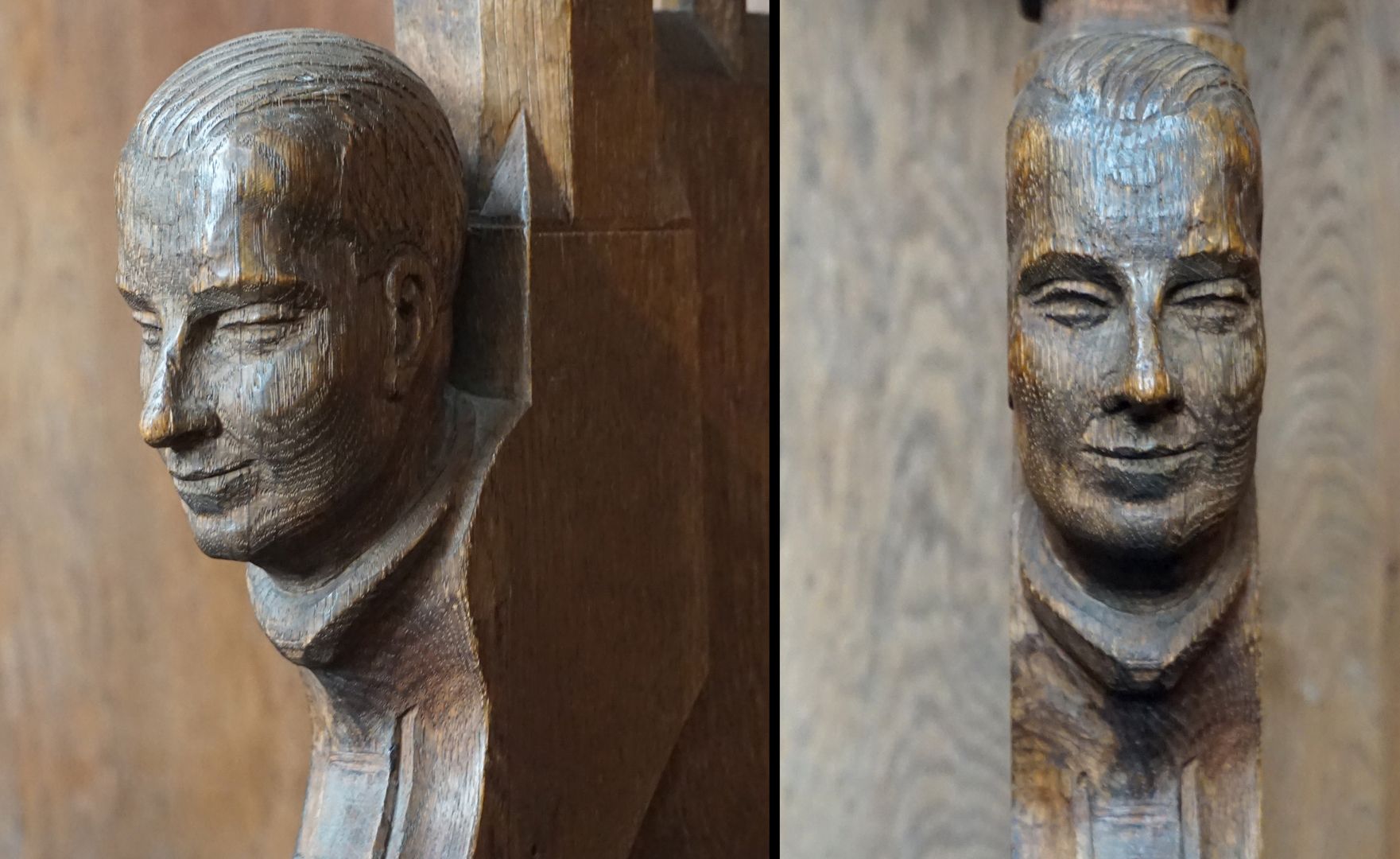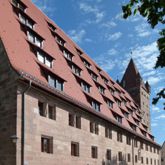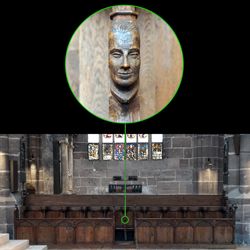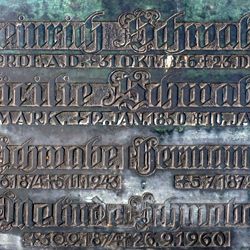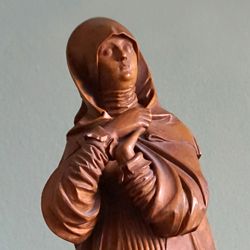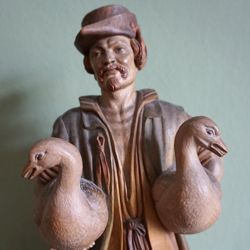Carved portrait of Julius Lincke
Carved portrait of Julius Lincke
ca. 1952
Choir stalls in the hall choir
Julius Lincke and St. Lorenz, perhaps his most important work. "Here, Lincke began rebuilding the church as a freelance architect in 1945. It was largely destroyed in 1945. At least the sacrament house and the portal were saved by walling them in. The impossible was achieved: a church grew out of the rubble in the incredible time of just seven years. Lincke did not create a dubious, contemporary mixture of old and new. For example, he restored the missing 50 meters of the tracery parapet as it was and not as an iron rod parapet as suggested by a monument conservationist." One employee said: "He did not want to create his own work, but rather restore the Lorenz Church." (...) Harald Pollmann (in the Nürnberger Nachrichten / 02.07.2009) _____________ Carl Rohlederer was instrumental in the restoration of the choir stalls after the Second World War and was therefore also responsible for the modern carved heads Two other heads are said to represent Pastor Kübel and Pastor Klein. _____________ Lit.: Stadtlexikon Nürnberg, edited by Michael Diefenbacher and Rudolf Endres Nuremberg, 1999, page 632
Location: Nuremberg, St. Lorenz Church, hall choir
Realization: Rohlederer, Carl
Depicted: Lincke, Julius
Material: Wood
photo 2023, Pablo de la Riestra
Carved portrait of Julius Lincke
ca. 1952
Choir stalls, south side
Julius Lincke and St. Lorenz, perhaps his most important work. "Here, Lincke began rebuilding the church as a freelance architect in 1945. It was largely destroyed in 1945. At least the sacrament house and the portal were saved by walling them in. The impossible was achieved: a church grew out of the rubble in the incredible time of just seven years. Lincke did not create a dubious, contemporary mixture of old and new. For example, he restored the missing 50 meters of the tracery parapet as it was and not as an iron rod parapet as suggested by a monument conservationist." One employee said: "He did not want to create his own work, but rather restore the Lorenz Church." (...) Harald Pollmann (in the Nürnberger Nachrichten / 02.07.2009) _____________ Carl Rohlederer was instrumental in the restoration of the choir stalls after the Second World War and was therefore also responsible for the modern carved heads Two other heads are said to represent Pastor Kübel and Pastor Klein. _____________ Lit.: Stadtlexikon Nürnberg, edited by Michael Diefenbacher and Rudolf Endres Nuremberg, 1999, page 632
Location: Nuremberg, St. Lorenz Church, hall choir
Realization: Rohlederer, Carl
Depicted: Lincke, Julius
Material: Wood
photo 2024, Theo Noll
Carved portrait of Julius Lincke
ca. 1952
Partitions between the seats (intermediate cheeks) with "character heads", in the front the portrait head of Julius Lincke
Julius Lincke and St. Lorenz, perhaps his most important work. "Here, Lincke began rebuilding the church as a freelance architect in 1945. It was largely destroyed in 1945. At least the sacrament house and the portal were saved by walling them in. The impossible was achieved: a church grew out of the rubble in the incredible time of just seven years. Lincke did not create a dubious, contemporary mixture of old and new. For example, he restored the missing 50 meters of the tracery parapet as it was and not as an iron rod parapet as suggested by a monument conservationist." One employee said: "He did not want to create his own work, but rather restore the Lorenz Church." (...) Harald Pollmann (in the Nürnberger Nachrichten / 02.07.2009) _____________ Carl Rohlederer was instrumental in the restoration of the choir stalls after the Second World War and was therefore also responsible for the modern carved heads Two other heads are said to represent Pastor Kübel and Pastor Klein. _____________ Lit.: Stadtlexikon Nürnberg, edited by Michael Diefenbacher and Rudolf Endres Nuremberg, 1999, page 632
Location: Nuremberg, St. Lorenz Church, hall choir
Realization: Rohlederer, Carl
Depicted: Lincke, Julius
Material: Wood
photo 2024, Theo Noll
Carved portrait of Julius Lincke
ca. 1952
Portrait head of Julius Lincke
Julius Lincke and St. Lorenz, perhaps his most important work. "Here, Lincke began rebuilding the church as a freelance architect in 1945. It was largely destroyed in 1945. At least the sacrament house and the portal were saved by walling them in. The impossible was achieved: a church grew out of the rubble in the incredible time of just seven years. Lincke did not create a dubious, contemporary mixture of old and new. For example, he restored the missing 50 meters of the tracery parapet as it was and not as an iron rod parapet as suggested by a monument conservationist." One employee said: "He did not want to create his own work, but rather restore the Lorenz Church." (...) Harald Pollmann (in the Nürnberger Nachrichten / 02.07.2009) _____________ Carl Rohlederer was instrumental in the restoration of the choir stalls after the Second World War and was therefore also responsible for the modern carved heads Two other heads are said to represent Pastor Kübel and Pastor Klein. _____________ Lit.: Stadtlexikon Nürnberg, edited by Michael Diefenbacher and Rudolf Endres Nuremberg, 1999, page 632
Location: Nuremberg, St. Lorenz Church, hall choir
Realization: Rohlederer, Carl
Depicted: Lincke, Julius
Material: Wood
photo 2024, Theo Noll
Carved portrait of Julius Lincke
ca. 1952
Portrait head of Julius Lincke
Julius Lincke and St. Lorenz, perhaps his most important work. "Here, Lincke began rebuilding the church as a freelance architect in 1945. It was largely destroyed in 1945. At least the sacrament house and the portal were saved by walling them in. The impossible was achieved: a church grew out of the rubble in the incredible time of just seven years. Lincke did not create a dubious, contemporary mixture of old and new. For example, he restored the missing 50 meters of the tracery parapet as it was and not as an iron rod parapet as suggested by a monument conservationist." One employee said: "He did not want to create his own work, but rather restore the Lorenz Church." (...) Harald Pollmann (in the Nürnberger Nachrichten / 02.07.2009) _____________ Carl Rohlederer was instrumental in the restoration of the choir stalls after the Second World War and was therefore also responsible for the modern carved heads Two other heads are said to represent Pastor Kübel and Pastor Klein. _____________ Lit.: Stadtlexikon Nürnberg, edited by Michael Diefenbacher and Rudolf Endres Nuremberg, 1999, page 632
Location: Nuremberg, St. Lorenz Church, hall choir
Realization: Rohlederer, Carl
Depicted: Lincke, Julius
Material: Wood
photo 2024, Theo Noll
